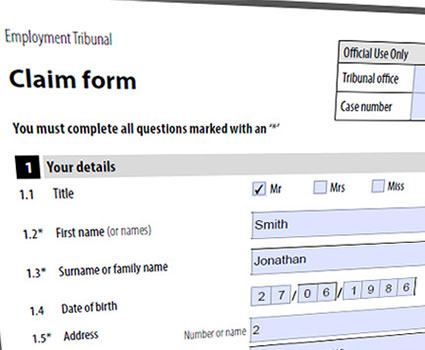Employment Tribunal Claims and Representation
Before Issuing a Claim in the Employment Tribunal: ACAS Early Conciliation
In most cases, you will not be able to issue a claim in the Employment Tribunal unless you have referred your case to the Advisory Conciliation and Arbitration Service (ACAS) for early conciliation in the first instance. ACAS is a free, independent and impartial organisation that can help to try to resolve the dispute between you and your employer without the need to bring proceedings in the Employment Tribunal.
You can start the early conciliation process either by contacting ACAS by telephone or by completing the early conciliation notification form online. You will then be contacted by an ACAS conciliation officer who will ask you for some basic administrative details and whether you wish to engage in early conciliation. ACAS will not contact your employer if you do not want them to do so.
If you don’t want to engage in early conciliation, or if the process does not resolve the dispute satisfactorily, you will be given an early conciliation certificate containing the reference number that you need to include with your claim form if you decide to issue proceedings in the Employment Tribunal.
Issuing a Claim in the Employment Tribunal
 Your claim form (on Form ET1) must be submitted at the relevant Employment Tribunal by the deadline applicable to your particular case, which we can advise you about. If you fail to meet the relevant deadline, it is very unlikely that you will be able to pursue your claim.
Your claim form (on Form ET1) must be submitted at the relevant Employment Tribunal by the deadline applicable to your particular case, which we can advise you about. If you fail to meet the relevant deadline, it is very unlikely that you will be able to pursue your claim.
Tribunal fees were abolished on 26 July 2017 and there is currently no fee to issue a claim.
Your claim form should be carefully drafted so that it includes all of your potential claims and details of the relevant facts surrounding your case. We can help you with this so that you get it right.
When the Tribunal accepts your claim, it will serve a copy on your employer, who then has 28 days to submit its defence (on form ET3) at the Tribunal. When the Tribunal accepts the ET3, it will send a copy to you (or to us, if you have instructed us to represent you).
The next stage is for an Employment Judge to look at the ET1 and ET3. If everything seems largely in order, the Judge will send a standard “case management order” letter to both parties, setting out a timetable for what needs to be done to prepare for the final hearing. If there are any preliminary issues that need addressing, the Judge may list the case for a “preliminary hearing” to consider those issues as well as to agree the timetable of preparations for the final hearing.
The timetable of preparation for the final hearing usually includes the following directions:
- The Claimant to prepare a “schedule of loss” setting out their financial losses.
- Both parties to exchange lists and copies of all relevant documentation.
- The parties to agree the contents of a joint hearing bundle.
- Both parties to prepare and exchange witness statements.
The complexity of the claim and the likely number of witnesses for each party will determine the length of the final hearing needed and a date will usually be set for this at the same time.
You might like to consider spending a morning or afternoon at another hearing at the Employment Tribunal, to give you an insight into the process and hopefully make you feel more at ease on the day of your own hearing. You can arrange this by telephoning the relevant Tribunal office directly.
The Day of the Hearing
You will need to arrive at the Employment Tribunal around 9am and you will be shown by the clerks where to wait. Hearings will usually start at 10am, but sometimes the Judge may ask for some time to read all of the paperwork before calling the parties in.
It is common for discussions to take place between the parties’ representatives during these waiting periods and last minute settlement negotiations often take place.

The Hearing
Employment Tribunals are fairly informal compared to other courts. You won’t find any barristers wearing wigs or robes. The Tribunal Panel that will listen to the evidence and make a decision is made up of:-
- One legally qualified Employment Judge; and
- Two lay members – one with an employer background (e.g. CBI) and one with an employee background (e.g. trade union).
The Panel will sit at the front of the room behind a large desk. The parties will sit at smaller desks on separate sides of the room in front of the Panel, next to their representatives. The witnesses and any other observers will sit in rows of chairs at the back of the room.
After swearing an oath to confirm that their evidence is the truth, witnesses will give their evidence seated at a separate witness table in front of the Panel.
The contents of the agreed hearing bundle will be referred to throughout the hearing.
The Running Order
There is no general rule about the order of proceedings but, using an unfair dismissal case as an example, it could be as follows:
- Respondent witness gives evidence and answers any questions from its representative;
- Respondent witness is cross-examined by the Claimant’s representative;
- Respondent witness is asked questions by the Panel;
- The above steps are followed in respect of the Claimant and the Claimant’s witnesses;
- The parties’ representatives summarise the evidence and each party’s case;
- The Panel make their judgment.
The Judgment
Depending on how much time is left, the Panel may adjourn to reach their decision and deliver its judgment, or it may “reserve” its judgment to be sent in writing or delivered at a later date.
If the claim is successful, compensation will be considered, or a further date may be listed if there is not enough time.
Costs and Appeals
Even if you are successful with your claim, it is very unlikely that the Respondent will be ordered to pay anything towards your legal costs. This is why it is very important for a cost/benefit analysis to be carried out regularly throughout your case (which we will do), to ensure that the cost of your case is proportionate to the amount of compensation that you can expect to receive, and so that appropriate settlement opportunities can be considered. In certain limited circumstances, the Tribunal may order one side to pay costs to the other (e.g. where one of the side’s has brought or conducted their case unreasonably).
Appeals against Employment Tribunal judgments can only be made in very limited circumstances, such as where the Tribunal has misapplied the law – you will not be entitled to appeal simply because you don’t agree with the Tribunal’s findings of fact or decision.
Settlement
Cost is not the only consideration when it comes to litigation. You also have to factor in the length of time it can take, the stress that it can cause and, of course, the risks and uncertainty of litigation.
The vast majority of employment cases do in fact settle before final hearing, either through ACAS (who continue to be available to assist after the early conciliation period), or by way of a settlement agreement negotiated by direct discussion between the parties’ representatives – see our separate guide to settlement agreements.
How Can We Help You?
We can advise and support you through the Tribunal process, from representing you during the early conciliation process, to drafting the ET1 claim form, through to the final Tribunal hearing (unless earlier settlement is reached, which we can also assist with).
We can also arrange for you to be professionally represented at the Tribunal hearing, either by us or by a barrister that we work closely with. Your options for representation will be discussed with you, so that you can decide what suits you best and what is most cost-effective in the circumstances.
If you need any assistance with Employment Tribunal claims, please contact a member of our team.

